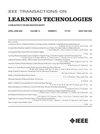用交替自回归建模增强知识跟踪
IF 2.9
3区 教育学
Q2 COMPUTER SCIENCE, INTERDISCIPLINARY APPLICATIONS
引用次数: 0
摘要
知识追踪(KT)旨在根据学生以前的练习和教育环境中的附加信息预测学生未来的表现。KT因在教育情境中提供个性化体验而备受关注。同时,对先前的练习序列进行自回归(AR)建模已被证明是有效的。AR建模的主要挑战之一是有效地表示学习者在练习中的前(反应前)和后(反应后)状态。现有的方法通常采用复杂的模型架构,利用问题和回答记录来更新学习者的状态。在这项研究中,我们提出了一种新的视角来看待KT任务,将其视为一个生成过程,与AR模型的原理一致。我们证明了知识状态可以通过AR编码在问答交替序列上直接表示,其中模型通过分析历史交互生成隐藏状态空间中最可能的表示。这种方法支持我们的框架,称为交替自回归KT (AAKT)。此外,我们通过辅助任务将补充教育信息(如与问题相关的技能)合并到我们的框架中,并将额外的练习细节(如响应时间)作为额外的输入。我们提出的框架使用来自自然语言生成的先进AR技术来实现训练和预测。对四个实际KT数据集的经验评估表明,AAKT在接收器工作特征曲线下的面积、精度和均方根误差方面始终优于所有基线模型。此外,广泛的消融研究和可视化分析验证了AAKT关键成分的有效性。本文章由计算机程序翻译,如有差异,请以英文原文为准。
AAKT: Enhancing Knowledge Tracing With Alternate Autoregressive Modeling
Knowledge tracing (KT) aims to predict students' future performances based on their former exercises and additional information in educational settings. KT has received significant attention since it facilitates personalized experiences in educational situations. Simultaneously, the autoregressive (AR) modeling on the sequence of former exercises has been proven effective for this task. One of the primary challenges in AR modeling for KT is effectively representing the anterior (preresponse) and posterior (postresponse) states of learners across exercises. Existing methods often employ complex model architectures to update learner states using question and response records. In this study, we propose a novel perspective on KT task by treating it as a generative process, consistent with the principles of AR models. We demonstrate that knowledge states can be directly represented through AR encodings on a question–response alternate sequence, where model generate the most probable representation in hidden state space by analyzing history interactions. This approach underpins our framework, termed alternate autoregressive KT (AAKT). In addition, we incorporate supplementary educational information, such as question-related skills, into our framework through an auxiliary task, and include extra exercise details, such as response time, as additional inputs. Our proposed framework is implemented using advanced AR technologies from Natural Language Generation for both training and prediction. Empirical evaluations on four real-world KT datasets indicate that AAKT consistently outperforms all baseline models in terms of area under the receiver operating characteristic curve, accuracy, and root mean square error. Furthermore, extensive ablation studies and visualized analysis validate the effectiveness of key components in AAKT.
求助全文
通过发布文献求助,成功后即可免费获取论文全文。
去求助
来源期刊

IEEE Transactions on Learning Technologies
COMPUTER SCIENCE, INTERDISCIPLINARY APPLICATIONS-
CiteScore
7.50
自引率
5.40%
发文量
82
审稿时长
>12 weeks
期刊介绍:
The IEEE Transactions on Learning Technologies covers all advances in learning technologies and their applications, including but not limited to the following topics: innovative online learning systems; intelligent tutors; educational games; simulation systems for education and training; collaborative learning tools; learning with mobile devices; wearable devices and interfaces for learning; personalized and adaptive learning systems; tools for formative and summative assessment; tools for learning analytics and educational data mining; ontologies for learning systems; standards and web services that support learning; authoring tools for learning materials; computer support for peer tutoring; learning via computer-mediated inquiry, field, and lab work; social learning techniques; social networks and infrastructures for learning and knowledge sharing; and creation and management of learning objects.
 求助内容:
求助内容: 应助结果提醒方式:
应助结果提醒方式:


